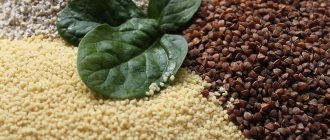What does adapted milk formula mean?
Baby food is called adapted because it is adapted for feeding babies from birth, which means it is as close as possible in composition and consistency to human milk.
For example, such products for newborns contain whey protein, which is found in mother’s milk and is more easily absorbed by the baby’s body than casein, the protein in cow’s milk.
The best lactose-free baby formulas
Lactose-free formulas are recommended for children prone to allergies to cow's milk protein. The “BL” or “LF” marking on the packaging helps to find them among others.
Humana SL
5
★★★★★
editorial assessment
100%
buyers recommend this product
Humana dairy-free formula is designed for babies who cannot tolerate cow's milk. The formula is suitable not only for artificial feeding of infants from birth, but also for complementary feeding of older children. It is based on hypoallergenic soy proteins. Omega-3 and Omega-6 ensure the proper formation of the brain and visual organs.
The powder dissolves quickly without lumps and does not foam when shaken. Kids like the sweetish taste - they eat the mixture with pleasure. The composition is produced in Germany.
Pros:
- contains a complex of fatty acids;
- hypoallergenic composition without lactose;
- sweet pleasant taste.
Minuses:
- cost (from 650 rubles per 500 g);
- difficult to find on sale.
The product is sold in cardboard boxes of 500 g. At the bottom of the package there is a complete measuring spoon.
Similac Alimentum
4.8
★★★★★
editorial assessment
87%
buyers recommend this product
Infant formula based on fully hydrolyzed casein is suitable for newborns with milk protein allergies and excludes palm oil, gluten and lactose.
The formula contains easily digestible fats that support stable functioning of the gastrointestinal tract. It has been clinically proven that the composition reduces colic in the first day after starting to take the mixture. The formula is suitable for newborns and has no age restrictions.
A proprietary complex of fatty acids and vitamins promotes the harmonious development of the brain in the first months of life. The mixture is produced in 400 g tins with an airtight lid and a measuring spoon inside. The powder dissolves quickly, leaving no lumps.
Pros:
- easily digestible lactose-free formula;
- convenient packaging;
- first effect within 24 hours;
- no age restrictions.
Minuses:
- expensive (about 1450 rubles for 400 g);
- specific taste and smell.
There are promotions in stores for products from this manufacturer. If you track them, you can buy the product at a better price.
What is the composition of adapted mixtures?
In addition to special protein, milk formulas must include components of breast milk, which help a bottle-fed baby to fully develop. Here are the main ones:
•Microelements – iodine, calcium, potassium and phosphorus. They help improve metabolism, build bones and other tissues of the body.
•Nucleotides – form the baby’s strong immunity and digestive system.
•PUFAs or polyunsaturated fatty acids are extremely important for the development of mental activity, nerve cells and vision.
•Oligosaccharides of mother's milk are the newest component that scientists have learned to synthesize and add to baby food quite recently - in 2021. Therefore, it is included in the food supply of only the largest manufacturers. And these products are more expensive than others. But this is a very important component - carbohydrates, which are involved in the development of the child’s immunity.
•Taurine is an amino acid that is very important for infants and premature babies. It affects the development of the baby’s nervous system.
Baby food for infants may also contain other components, for example, pre- and probiotics, other minerals, vitamins and amino acids.
The best anti-reflux baby formulas
Antireflux infant formulas are classified as therapeutic diets. They are prescribed by pediatricians for babies up to 6 months to reduce regurgitation. The consistency of such compositions is thicker than that of conventional compositions.
Friso VOM 2
5
★★★★★
editorial assessment
97%
buyers recommend this product
Friso VOM is a special milk formula for babies suffering from excessive regurgitation or other digestive disorders. The line includes an option for feeding newborns up to six months and a diet for infants from 6 to 12 months. The composition forms the correct intestinal microflora and softens the stool. The result is visible after the first dose. The mixture is suitable for complete replacement of milk or partial introduction into the diet of healthy children.
Nucleotides strengthen the immune system. The complex of fatty acids stimulates the development of sharp vision and brain. Prebiotics improve the functioning of the gastrointestinal tract. The thick consistency is provided by a natural component - carob gum without high-temperature treatment. Vitamins and minerals are selected according to the needs of babies.
The composition is sold in tin cans of 400 or 800 g. The lids with a seal securely close the packaging and prevent the mixture from getting damp. The set includes a measuring spoon; there is a limiter on the jar to remove excess mixture from it and ensure the most accurate dosage.
Pros:
- Suitable for babies from birth to one year;
- improves digestion;
- strengthens the immune system;
- promotes the proper development of the child;
- quick results;
- convenient jar and spoon.
Minuses:
- not sold everywhere;
- complex preparation.
The mixture must be diluted with water at a temperature not lower than 75 degrees. Then you will have to wait 5-10 minutes until the fibers swell. Only then can the solution be cooled for feeding the baby.
Nutrilak Premium Antireflux
4.9
★★★★★
editorial assessment
96%
buyers recommend this product
Nutrilak Premium anti-reflux formula is suitable for artificial or mixed feeding of babies with digestive disorders from birth to one year. The basis of the formula is high-quality whey protein. The composition is enriched with a complex of vitamins, minerals and Omega-3. Calcium and vitamin D strengthen rapidly growing teeth and bones. Iron and zinc prevent anemia.
The mixture contains natural milk fat, which is necessary for brain development and proper metabolism. Gangliosides and phospholipids are important for the development of the nervous system. Cholesterol prevents cardiovascular diseases in the future. Palmitic acid is a source of energy for infants and promotes the absorption of calcium.
Pros:
- composition enriched with vitamins and fatty acids;
- improves child digestion;
- reduces regurgitation;
- establishes regular bowel movements;
- easy to prepare.
Minuses:
- thickens quickly;
- inconvenient packaging.
The prepared mixture should be drunk immediately - leftovers should not be left until the next feeding. The composition helps with regurgitation and colic, is easy to stir and is suitable for most babies.
Bellakt AR
4.8
★★★★★
editorial assessment
90%
buyers recommend this product
Bellact AR - anti-reflux in cow's milk for newborns up to six months is prescribed for digestive disorders. Carob gum provides a healing effect. It is not digested in the stomach - due to this, the body cannot expel the swollen fibers. This improves intestinal motility, reduces the frequency of regurgitation, and improves bowel regularity.
Also added to the formula are the components necessary for the harmonious growth of the child: prebiotics, nucleotides, vitamin-mineral complex, fatty acids. The composition is sold in cardboard boxes of 400 g.
Pros:
- reduces regurgitation;
- high nutritional content;
- regulates stool frequency;
- low price (about 300 rubles per 400 g).
Minuses:
- inconvenient packaging;
- difficult to dissolve.
To prepare the mixture, you need to shake it for a long time and break up the lumps. Experienced mothers advise using a mixer or blender to speed up the process.
READ ALSO
10 Best Bottle Warmers
Partially adapted mixtures
From the age of six months, the baby’s body’s needs for nutrients change. At this time, complementary foods begin to be introduced and baby food becomes more varied in composition. Manufacturers still strive to make it similar to breast milk, but add casein instead of whey protein, because the baby’s body is ready to absorb it. Sometimes palm oil, starch or glucose appear at this stage.
By age, these are stages 2 and 3, that is, nutrition after 6 months and from 1 year.
The best baby formulas for colic and constipation
If your baby has problems with bowel movements and colic, you need to change his diet. However, first you should make sure that the child does not have congenital diseases or functional disorders.
MAMAKO 1 Premium
5
★★★★★
editorial assessment
98%
buyers recommend this product
MAMAKO 1 Premium is a goat milk-based formula for babies from birth. The composition is as close as possible to breast milk and does not contain palm oil or other harmful additives.
The proprietary IQ complex with lutein ensures the child’s cognitive activity and the correct formation of the visual organs. To prevent colic and constipation, bifidobacteria, prebiotics and probiotics are added to the composition, which restore intestinal microflora, normalize the baby’s digestion, form soft stools and strengthen the immune system.
L-carnitine improves metabolism and helps absorb the components of the mixture. Calcium, iron and iodine are added to prevent rickets, anemia and iodine deficiency. Nucleotides strengthen the immune system and protect against adverse environmental factors.
Pros:
- well absorbed;
- improves the functioning of the digestive and immune systems;
- disease prevention;
- Convenient jar with spoon and limiter.
Minuses:
- price (from 1000 rubles per 400 g);
- not always available in stores.
The powder is sold in cans of 400 or 800 g. The lid reliably protects the contents from moisture. The included spoon and limiter on the package allow you to accurately dose the mixture.
Nutrilon 2 Comfort
4.8
★★★★★
editorial assessment
90%
buyers recommend this product
Nutrilon 2 Comfort is a dry formula for babies over 6 months suffering from constipation and colic. Prebiotics in its composition quickly improve digestion. Vitamin complex, minerals, trace elements and fatty acids contribute to the harmonious development of the baby. L-tyrosine provides mental alertness. L-carnitine supports the immune system and the vascular system, and nucleotides provide the child with energy.
Pros:
- convenient packaging;
- sold in most stores;
- safe, highly adapted composition;
- quickly relieves colic and normalizes stool.
Minuses:
- bitter;
- the measuring spoon is buried deep.
The mixture must be diluted with water at a temperature no higher than 40 degrees, otherwise the composition loses some of its beneficial properties.
Special adapted mixtures
Special formulas for infants are also classified as adapted, because manufacturers strive to bring their composition closer to breast milk. However, they also solve narrow problems, for example:
•Antireflux
– help reduce the frequency and volume of regurgitation;
•Soybeans
– suitable for children with lactase deficiency or allergy to casein. If you are not allergic to soy;
•Formulas for premature babies
help you gain weight faster;
•Low lactose
— for children with temporary lactose intolerance;
•Hypoallergenic
– based on partially digested protein. They are intended for allergic babies for whom no other formula is suitable;
•Fermented milk
- prescribed for children who find it difficult to digest regular milk.
Formula according to the child’s age: how to choose the right one?
The classification of infant formula by age is based on the changing needs of the child during the process of growth and development. How big is the difference between formulas for newborns and grown-up babies, when to give this or that formula and how adaptation is related to them, says pediatrician Ekaterina Borisovna Bulavina.
— Ekaterina Borisovna, why do manufacturers make different formulas for children of different ages?
— The production of infant formula is based on the properties of breast milk, the composition of which changes throughout the entire period of lactation and largely depends on the energy needs of the child, the health of the mother, its psycho-emotional state, the adequacy of the diet and many other factors.
How does breast milk change as the baby ages?
| During the first 3-5 days of lactation, the baby receives colostrum |
|
| Over the next 3-4 weeks, the mother feeds the baby with transitional milk |
|
| Mature milk is then produced |
|
| Breast milk after 3 months of lactation |
|
| Natural completion of lactation at the age of 2-3 years, sometimes 4 years |
|
— Modern infant formulas are also developed based on the physiological needs of the child. It is extremely difficult to replace colostrum, but baby food manufacturers try to adapt the formula as much as possible to the needs of a child from 0 to 6 months, from 6 to 12 months, and also create preformulas for premature babies and subsequent formulas for children after one year.
— What is the difference between formulas for children of different ages and what is the infant formula formula?
— A formula refers to the composition of an infant formula that meets a certain standard. Each formula has its own number according to a specific age period.
Classification of infant formula by age
| Starter mixtures, or formulas “1” - for the first half of the year, from 0 to 6 months | Infant formulas from age 0 are adapted in composition to mature mother's milk, but, unfortunately, cannot replace valuable colostrum. Therefore, early latching of the baby to the breast already in the delivery room and feeding with colostrum in the first days is very important. |
| Subsequent mixtures, or formulas “2” - for the second half of the year, from 6 to 12 months | They are characterized by lower protein content, but higher calorie content due to fat and carbohydrate components, contain more vitamins and minerals, which meets the needs of a growing child. |
| Subsequent formulas (baby milk), or formulas “3” - from 1 year to 3 years | Used as an additional source of protein, calcium, phosphorus, B vitamins, iron and other important microelements, polyunsaturated fatty acids. |
| Formulas for premature babies, or preformulas, for babies with extremely low body weight | They are distinguished by their high content of proteins, fats and carbohydrates, some microelements, for example, iron, calcium, vitamin D, as well as high calorie content and reduced lactose content. |
— This age classification of mixtures corresponds to the physiological needs of the child at different stages of development. And it is the same for all manufacturers, and within each formula variations are possible in accordance with the solution to a specific problem. For example, hypoallergenic, fermented milk, lactose-free, anti-reflux and other mixtures are produced.
— Is it possible to give formula for those who are not age-appropriate?
— It is very important to feed your baby a formula appropriate for his age. An incorrectly selected mixture can provoke the development of serious diseases in the baby.
- The composition of the first formula takes into account the physiological immaturity of the gastrointestinal tract of the newborn. The second formula is not suitable for it either in terms of calorie content or quality composition due to the high load on the gastrointestinal tract and kidneys.
- Feeding a child older than six months with the first formula is also undesirable: the composition of the second formula is more suitable for this age. For example, the amount of protein has been increased for the harmonious growth of the baby.
Signs of disorders that may occur if the mixture is given inappropriately for age:
- abnormal—too little or too much—weight gain;
- delay in psychomotor development;
- lethargy, apathy, disinterest in what is happening around;
- problems with the gastrointestinal tract - colic, regurgitation, pain, constipation or diarrhea, mucus, streaks of blood in the stool.
— Ekaterina Borisovna, is it possible to transfer a child to a new formula independently, without consulting a doctor?
— When switching to a new formula for a healthy child, consultation with a specialist is not necessary. A baby who has digestive problems, low weight gain, signs of allergies or other pathologies should discuss changing the formula with a pediatrician. You may need a different type of formula from a different manufacturer to solve your baby's specific health problems. For example, choose a hypoallergenic or hydrolyzed mixture for a child with allergies.
If the child tolerates the mixture of the initial formula well, then when switching to the second formula it is better to choose a mixture from the same manufacturer. Changing the mixture within the same brand is easier to tolerate.
— How to switch to a new formula: abruptly or gradually?
— The transition to a new formula according to age is carried out gradually for babies both on artificial and mixed feeding. To begin with, introduce 10 ml of the new mixture into the first feeding and monitor the baby’s condition throughout the day. With a normal reaction of the body, the volume of the mixture is gradually increased to the daily norm. There are different schemes:
|
|
— What should parents do if their child refuses a new formula?
— Initially, you should make sure that refusal of formula is not related to the baby’s health condition. He might be teething, getting sick, or having a stomach bug. Then the refusal is quite understandable and the introduction of a new mixture can be postponed for some time.
If everything is in order with health, then you need to gently but persistently offer new food, observing the recommended intervals between feedings so that the baby has time to get hungry. Not a single child has ever voluntarily starved himself to death. In case of categorical refusal of the baby, a consultation with a pediatrician is necessary for the possible selection of another formula.
— Let's talk about adapted mixtures for early ages. What are their features and advantages?
— Adapted milk formulas include those whose composition differs minimally from the composition of human breast milk. They are prepared from cow's and goat's milk, but the final product is significantly different from the original raw material.
Adapted milk formulas
| Protein component | Adapted by:
|
| Fat component | The fats of whole milk are partially replaced with vegetable oils, due to which the adapted mixtures are enriched with polyunsaturated fatty acids, as well as Omega-3, -6 in the optimal ratio. The mixtures are also enriched with emulsifiers (for example, lecithin) - substances that help the absorption of fatty acids. |
| Carbohydrate component | The carbohydrate content in animal milk is lower, so the mixture is additionally enriched with lactose, as well as such important substances as oligosaccharides in accordance with the physiological needs of the baby. |
Partially adapted milk formulas
— After a year, it is possible to add a partially adapted mixture to the child’s diet, since the body is already ready to absorb it. The main differences between formulas for children over one year of age are the presence of a larger amount of casein protein, sucrose, and less stringent requirements for fat composition. Otherwise, it repeats the composition of formulas up to a year and is also enriched with additional components, vitamins, minerals in accordance with the physiological needs of the child.
Unadapted baby food products
— Feeding a child of the first year of life with unadapted products in the form of whole cow’s or goat’s milk is unacceptable. Whole milk contains more protein and some minerals than breast milk, which puts undue stress on immature kidneys and triggers metabolic changes in the baby's body. Colitis, constipation, diarrhea, regurgitation occur, the kidneys do not work properly and remove beneficial microelements that the child needs so much. Whole milk proteins can cause allergic reactions. Also, cow's milk contains too much calcium and phosphorus, which creates additional stress on the excretory organs. But there is not enough iron in it. Children fed with unadapted formulas usually suffer from anemia.
In terms of nutritional value, goat's milk is close to cow's milk, but it contains more polyunsaturated fatty acids and a higher content of medium-chain fatty acids, which are much easier for the body to absorb. However, it does not contain enough folic acid, which is compensated for in the composition of adapted mixtures.
— How to choose the best baby formula?
— Before introducing infant formula, almost every mother tries to thoroughly study this issue so as not to harm her baby. And, of course, the help of a doctor who knows the child from birth is priceless here.
The choice is based on three main components:
- Doctor's recommendations on the health and age of the child.
- Quantitative and qualitative composition of the mixture.
- Correct use of the mixture.
All manufacturers indicate on the packaging the formula numbers “1”, “2”, “3” in accordance with the child’s needs, as well as the age and method of preparing the mixture. In no case should you break concentration and prepare a thicker formula of the first formula for babies over six months old, or, conversely, it is unacceptable to buy a formula labeled “2” for a low-birth-weight newborn baby so that he gains weight better.
Important characteristics of the adapted mixture
- Demineralized whey.
- Protein content is no more than 1.3-1.4 g/l for babies from birth and up to 1.8-2 g/l for children over six months.
- The ratio of whey protein to casein is 60:40 in infant formulas in the first half of the year and 50:50 in infant formulas in the second half of the year.
- The presence of L-carnitine, nucleotides, pre- and probiotics is desirable.
— How do MAMAKO® Premium milk formulas differ from each other?
— The line of these mixtures is represented by three formulas, which have an adapted composition according to the age needs of the child.
| "1" formula | "2" formula | "3" formula | |
| Proteins, g/100 ml | 1,35 | 1,5 | 2 |
| Fats, g/100 ml | 3,4 | 3,2 | 3 |
| Carbohydrates, g/100 ml | 7,97 | 8 | 8 |
| Whey Protein to Casein Ratio | 60:40 | 50:50 | 20:80 |
| "1" formula | |||
| Proteins, g/100 ml — 1,35 | Fats, g/100 ml — 3,4 | Carbohydrates, g/100 ml — 7,97 | Whey Protein to Casein Ratio — 60:40 |
| "2" formula | |||
| Proteins, g/100 ml — 1,5 | Fats, g/100 ml — 3,2 | Carbohydrates, g/100 ml — 8 | Whey Protein to Casein Ratio — 50:50 |
| "3" formula | |||
| Proteins, g/100 ml — 2 | Fats, g/100 ml — 3 | Carbohydrates, g/100 ml — 8 | Whey Protein to Casein Ratio — 20:80 |
— It is worth noting that the fat component of goat mixtures plays an important role in the development of vision and the immune system. And it is very important to enrich the mixture with docosahexaenoic (DHA) and arachidonic (ARA) acids - their intake with food is very valuable for the baby’s body. The content of such fatty acids in MAMAKO® Premium mixtures of different formulas from “1” to “3” also decreases slightly, since from 4-6 months the child already receives complementary foods and other vegetable oils, which can serve as a source of polyunsaturated fatty acids.
In addition, all formulas are additionally enriched:
- Lutein - necessary for the proper formation of the visual organs. It has antioxidant activity and protects the retina from the harmful effects of ultraviolet rays.
- Oligosaccharides - these carbohydrates serve as a nutrient medium for the growth of beneficial microflora, promote comfortable digestion for the baby, and prevent constipation.
- Probiotics - bifidobacteria prevent the growth of opportunistic flora, have a positive effect on the formation of one’s own microbiota and, as a result, promote comfortable digestion.
- Nucleotides, L-carnitine, taurine, vitamins and minerals according to age-related needs.
Modern advances in science in the field of nutrition and pediatrics allow baby food manufacturers to create products that are maximally adapted in composition to the composition of breast milk. One of the ways of adaptation is to divide mixtures into formulas in accordance with the physiological needs of a child of each age period. It is very important to follow the recommendations when feeding a baby formula according to age. An unsuitable mixture can lead to the development of pathological conditions in the baby. For the harmonious growth and development of a child in the first year of life, it is necessary to feed with milk formulas that are adapted by age, and therefore by macro- and microelement composition.
Pediatrician Ekaterina Borisovna Bulavina
*The ideal food for an infant is mother's milk. WHO recommends exclusive breastfeeding for the first 6 months. MAMAKO® supports this recommendation. Before introducing new foods into your baby’s diet, consult a specialist.
MATERNA baby adapted formulas are now in Moscow!
MATERNA baby food is produced in Israel under the supervision of the Ministry of Health and the Chief Rabbinate of the country. Dairy and dairy-free mixtures, porridges and purees can be purchased in the Materna Shop online store with delivery from a warehouse in Moscow
Mixtures are always available. And the brand’s consultants and pediatrician will help you choose the right nutrition.
For all new customers, free delivery of the first order in Moscow or a 50% discount on delivery to the regions using the code word “Babyblog”.
Which baby formula is best to buy?
The mixture for babies has to be selected experimentally. Even the most popular formulations from well-known brands can cause individual intolerances, rashes and other concerns in the baby.
However, there are a number of standard rules for choosing a diet for a baby. The product must be age appropriate. The packaging always states what months of life the composition is intended for, and there are also detailed instructions for dosage and food preparation.
Specialized mixtures should be purchased only as directed by a doctor. If the chosen option does not cause negative reactions in the body, you should choose it.
Frequent changes in diet are not recommended for babies and can cause digestive problems.
Pediatricians advise buying products from brands that are widely represented in city stores and have a full line of nutrition for all ages. This will make the transition from one mixture to another smoother. When introducing a new diet, you need to carefully monitor the baby. If there are no skin rashes or problems with stool, the mixture is suitable.
Recommendations: 13 best baby cereals
14 Best Baby Bottles
16 Best Baby Food Products
How to understand that the mixture is not suitable
If after feeding the child is restless, reddening of the cheeks, frequent constipation, or the baby cries, these are the first signs that the formula is not suitable for feeding.
It is important for parents to remember that the mixture should be introduced into the diet gradually . It is not uncommon for a child to eat a lot of new formula when switching to a new diet, and it becomes poorly digestible.
Milk-based formulas
Such mixtures are the widest segment to choose from. The first thing you need to pay attention to is whether the mixture is adapted. Only in this case is it suitable for feeding children under 6 months. The adapted formula is as close as possible to breast milk in terms of quality and quantity of proteins, fats, carbohydrates, vitamins and minerals. The adapted mixture is necessarily enriched with whey, the percentage of which is close to its content in breast milk - at least 55% of the total protein. This mixture is closest in composition to breast milk. Consequently, it will be better digested and absorbed by the baby’s body. After 6 months of age, the child is offered subsequent adapted formulas - the nutritional value of which is as close as possible to breast milk, changing in accordance with age-related needs. It is acceptable to offer a partially adapted mixture, but such mixtures are gradually going out of circulation, because their composition is considered outdated and not the most optimal for a child.
The second important aspect when choosing a mixture is the completeness of its composition. It should include vitamin-mineral complexes, probiotics, prebiotics, nucleotides, polyunsaturated fatty acids, and vegetable oils. It is undesirable for the composition to contain components such as sugar and other sweeteners, soy, starch and preservatives.
In addition, it is worth paying attention to the milk base itself. Now on sale there are mixtures with cow's milk and goat's milk.
Adapted formulas based on cow's milk
They are suitable for feeding children from the first days of life. The protein composition of cow's milk differs significantly from the composition of breast milk. It contains more alpha casein than breast milk. In some babies, such nutrition, due to the immaturity of the gastrointestinal tract, can cause digestive disorders (constipation, flatulence, increased intensity of regurgitation). Therefore, the mixture must be selected based on the child’s individual reactions to it.
Adapted mixtures based on goat milk
A relatively young product on the Russian market, but it has already managed to win the trust of mothers. Such mixtures are softer in composition due to the low alpha-casein content. Goat's milk and mixtures based on it are digested faster and easier than mixtures based on cow's milk. Another plus is that goat milk-based formulas contain higher quantities of easier-to-digest beta-casein - in this they are more similar to breast milk. That is why such mixtures are optimal for babies, because... help to transition more smoothly and carefully from breastfeeding to mixed or artificial feeding. After all, a child of the first year of life is created by nature in such a way that his only food should be breast milk, and it is much more difficult for him to digest and absorb all other food.
Hypoallergenic mixtures
We should also talk about hypoallergenic mixtures, in which the protein component partly consists of split (hydrolyzed) protein. Such mixtures are usually prescribed as preventive nutrition to children with a history of allergies (there were allergy sufferers in the family). However, modern advanced pediatricians have an ambiguous attitude towards such mixtures for one simple reason - the quality of the protein in such mixtures is altered, so you should not abuse the prescription of such mixtures to healthy children.
Medicinal mixtures
- food for allergies to animal protein (hydrolysis, amino acid, soy mixtures)
- mixtures for correcting specific problems (anti-reflux, lactose-free, etc.)
- mixtures for children of varying degrees of intrauterine growth retardation.
For allergies to animal protein, pediatricians recommend special mixtures. Their basis is protein hydrolysates, amino acids or soy proteins. This food is prescribed to children who have allergic reactions to infant formula. Such mixtures are optimal for feeding allergy sufferers, since modified (split) milk protein is used as the protein base. Thanks to this processing, the product is better accepted by the child’s body. Such mixtures are selected and prescribed only by a pediatrician who assesses the severity of allergic manifestations. They are usually prescribed for 4-6 months (elimination diet), after which, under the supervision of a doctor, “provocative tests” are carried out (a regular formula is given); if such tests do not cause allergic reactions, then the child switches to eating regular formulas.
Fermented milk mixtures
These mixtures contain coagulated milk proteins. They are fermented with lacto- and bifidobacteria. Such food is also therapeutic and is offered to the child in case of abnormalities in the digestive processes. Thanks to the high concentration of beneficial bacteria, the child’s intestines are populated with positive microflora, which in turn helps to normalize digestion. Another advantage of fermented milk mixtures is that the milk protein in them is already curdled. This form is easier to digest by the baby’s stomach and intestines and does not cause discomfort. The dosage and feeding regimen for this type of food is selected by the pediatrician based on the child’s condition. Typically, such mixtures are prescribed for the duration of treatment and strictly for medical reasons. Well, many pediatricians are against such mixtures, because... Breast milk is insipid and, accordingly, such formulas can hardly be called as close as possible to maternal nutrition.
The best anti-colic mixture
Problems with colic cause discomfort not only for the baby, but also for the parents, since the pain causes the baby to constantly cry and scream. In this case, the best anti-colic mixture with a large number of useful elements will be suitable.
Friso VOM 1
Rating: 4.9
An excellent product that will help reduce the pain of colic and also prevent spitting up. The package has a dispenser ledge so that you can remove the slide from the measuring spoon. The mixture dissolves quickly, but leaves a slight sediment, so watch how much of the product the newborn drank.
The composition is increased, has many vitamins, as well as nucleotides and prebiotics. All this improves the digestion process and also normalizes the baby’s stool. We recommend using the product only after consulting a doctor.
In our opinion, the mixture, like Nutrilon (Nutricia) 1 fermented milk, is not suitable for use on an ongoing basis. Use it no more than 1-2 times a day so as not to cause addiction and, as the problem is solved, quickly transfer the baby to a regular formula.
Advantages
- fights colic, immediately reduces pain and after 2-3 days completely solves the problem;
- normalizes stool and gastrointestinal function;
- Suitable for frequent regurgitation.









